Table of contents
- Out and about in cultural capitals Motorcycle trip from Istanbul to the Ruhr area
- Out and about in Europe’s cultural cities: Part 2
- meal
- Pecs
- Istanbul
- Travel info
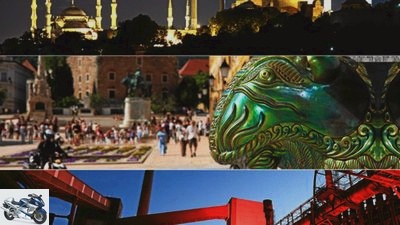
shepherd
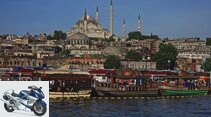
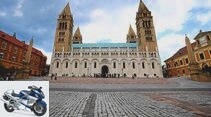
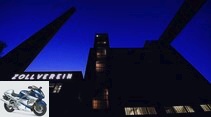
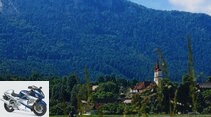
20th pictures
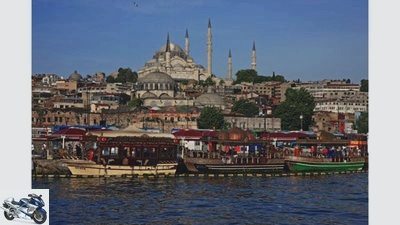
shepherd
1/20
The start in Istanbul: The Suleymaniye Mosque towers over the bay of the Golden Horn.
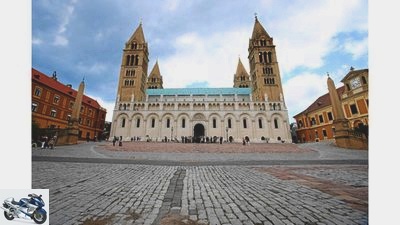
shepherd
2/20
Four wins: Four towers at the impressive Pecs Cathedral.

shepherd
3/20
Night shift: You can visit Zollverein until late at night.
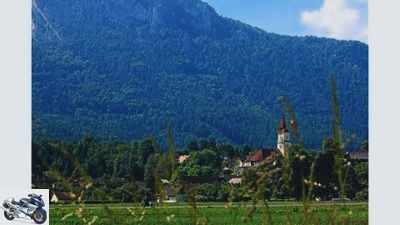
shepherd
4/20
Now quickly continue towards Essen and the Ruhr area.

shepherd
5/20
Anglers having tea break on the Galata Bridge.
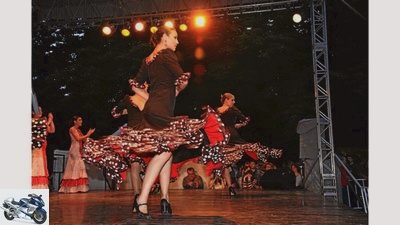
shepherd
6/20
Raises the temperature: Roma flamenco.
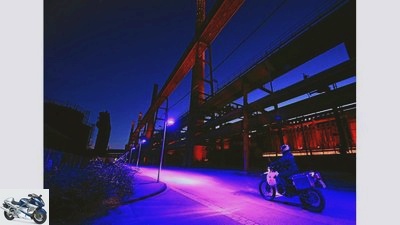
shepherd
7/20
Schimanski is in peace, as is the coal mine.
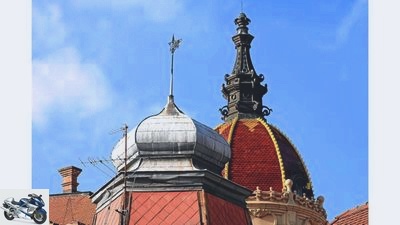
shepherd
8/20
What to get on the roof: District building on Szechenyiter Square.

shepherd
9/20
Now to the last of the three stations: The street of fire is still glowing in Essen.
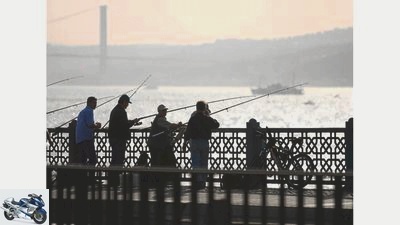
shepherd
10/20
Waiting for Moby Dick: More anglers on the Galata Bridge.
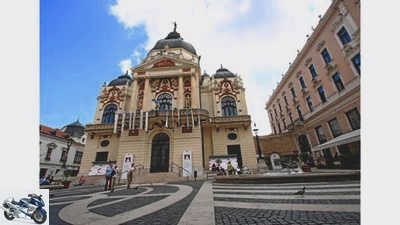
shepherd
11/20
We continue to the next cultural capital Pecs: The cultural heart of the city: the National Theater.
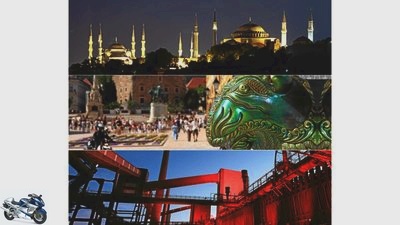
shepherd
12/20
After Essen, Pecs – in Hungary and Istanbul – in Turkey – the European Capitals of Culture were chosen, Dirk Schafer, who was chosen from Essen, set out to visit them. The route from Istanbul to Essen leads 2700 kilometers, past interesting monuments.
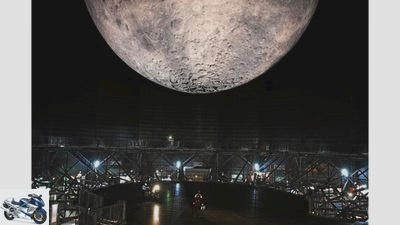
shepherd
13/20
In the Oberhausen gasometer you get close to the moon.
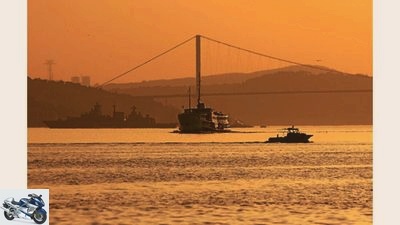
shepherd
14/20
Watery bottleneck: The Bosporus separates Europe from Asia.
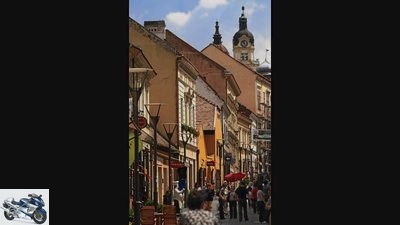
shepherd
15/20
Pecs also lives from opposites: a village street in the middle of the city.
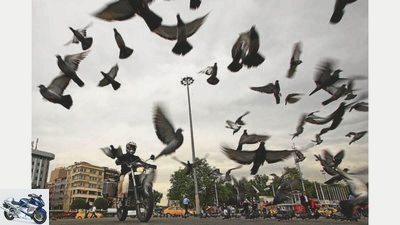
shepherd
16/20
Pigeon invasion in Taksim Square.

shepherd
17/20
On the direct route from Istanbul to Pecs.
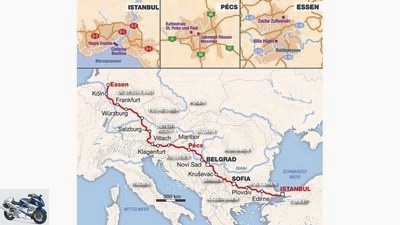
shepherd
18/20
The route from Istanbul to Essen.
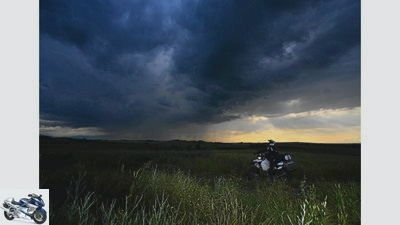
shepherd
19/20
Fate of a motorcyclist: We are about to extinguish it properly.

shepherd
20/20
Now smoke-free zone: chimneys at Zollverein.
to travel
On the way from Istanbul to the Ruhr area
Out and about in cultural capitals
Motorcycle trip from Istanbul to the Ruhr area
Every year Europe chooses the European Capitals of Culture, this year Essen, Istanbul and Pecs. No idea where Pecs is? The Essen-born Dirk Schafer didn’t have either until he visited Istanbul. Pecs is located in Hungary, on the direct route from Istanbul to Essen. In between, 2700 kilometers of new and old Europe. Let’s go.
Markus Biebricher
11/11/2010
Turkey, Istanbul. The first rays of the sun melt the haze over the still quiet bay of the Golden Horn. Out on the Bosphorus Strait, container ships and tankers pave their way from the Black Sea to the Marmara Sea. Here at the Galata Bridge, the ever-croaking seagulls are getting more and more noisy competition every minute. Trams roar over the bridge, and the sirens of the Bosporus ferries with the first commuters ring out below them as far as the Asian shore. The tinkling of spoons being stirred through hot tea glasses can be heard almost incidentally. Tea is always drunk here somewhere.
I have an appointment with Savas at the Galata Bridge at sunrise. He crossed all of America alone on a Kawasaki KLE 500. For one day he will show me his hometown. “Do you see where the ferries dock on the other side of the Bosphorus?” I blink past Sava’s ‘arm. “The Haydarpasha port station. We’ll take the ferry over there.” As a couple on the BMW Xchallenge, we maneuver through the roaring mass of cars to the Sirkeci harbor below the Topkapi Palace.
Buy complete article
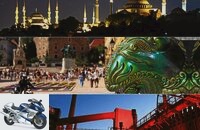
Out and about in cultural capitals
Motorcycle trip from Istanbul to the Ruhr area
10 pages) as PDF
€ 2.00
Buy now
“Sirkeci and Haydarpasha are the terminus for the railways from Europe and Asia. The Orient Express ends at one and the Baghdad Railway ends at the other. Haydarpasha has been specially renovated for the Capital of Culture.” Refurbished or not: Istanbul is the cultural capital as it is. 8,000 years of history cannot be denied, even with glass skyscrapers and eight-lane motorways.
The Xchallenge leans against the side of the ship together with an unidentifiable pile of two-wheelers. With every meter that our ferry takes out onto the Bosphorus, I am more enchanted: the minarets, the palaces, the bay of the Golden Horn, the swarm of ships. This is the place where continents made history, and you breathe them in with every salty breeze from the sea.
“Years ago a tanker exploded on the Bosporus.” Savas speaks against the wind as we roll off the ferry. “At that time, even the frames of Haydarpasha’s windows melted.” A bronze plate on the mighty station building reminds of the German engineers who built the railway line from here to Baghdad. The rails for the Baghdad Railway, which was supposed to bring imperial Germany closer to the oil reserves in the Middle East, came from Krupp in Essen. Until then it is around 2,700 kilometers. Exactly the distance that will lie in front of me from tomorrow.
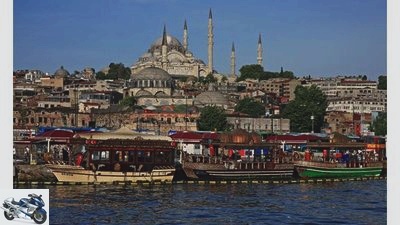
shepherd
The start in Istanbul: The Suleymaniye Mosque towers over the bay of the Golden Horn.
I’ve only been looking ahead for hours. The journey through Northern Turkey reads like the punctuation of the landscape. Scattered trees as commas, isolated farmsteads as stop marks for the eye. The words are waiting in the places decorated with minarets and in the earth flying by. It has absorbed the history of time. Alexander the Great, the Romans, the Ottomans: if you wanted to see the treasures of Asia, you had to go through here. Whoever wanted to conquer Europe, too.
I am entering the EU again with the Bulgarian border. Long before I reach Sofia, the lights of the Bulgarian capital are reflected in the cloudy night sky. I am stranded on the rain-soaked cobblestones of Vazrazhdane Square. Yellowish light from a hotel entrance sucks me in like a moth the light. The night watchman gives me quarters in one of the same rooms and recommends that I chain the BMW to the downpipe of the house. Sofia is dangerous. The city can’t be quite that risky. The downpipe is made of sloppy plastic.
Why are so many raving about Route 66 and nobody about the autoput? The cult route takes me quickly further north through Serbia. Sheet metal legends from Lada, Yugo and Zastava drive through a reserve that does not yet have limit values for particulate matter. And the rest areas still convey the brittle charm of socialist days. But there is still one excitement in a positive sense: the Sicevo Gorge with its 14 tunnels. But the real bringer is the canyon through which the road winds. A wonderful spot if a 40-ton truck isn’t roaring through the tunnels.
In Backi Breg, the last Serbian village before the Hungarian border, street lamps are already bathing the houses in a pale light. There, the limit! Since the internal borders of the EU can do without passport controls, the demands on customs officers at the external borders have increased. People smuggling, drugs and terrorists are just a few of the dangers they must protect us from.
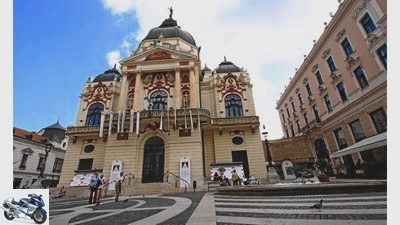
shepherd
We continue to the next cultural capital Pecs: The cultural heart of the city: the National Theater.
My customs officer takes his business very seriously: “Do you have Coca-Cola, cigarettes?”. “No.” He points to the left aluminum case. “Open the box!” Years of experience at customs will tell him that motorcycle travelers transport contraband in their left suitcase. The bolt pops open and sweaty T-shirts are on top. I can close the lid again without having to unpack. He waves me through, not realizing that a bottle of Turkish Efes beer is entering his territory in the box on the right.
Only 25 kilometers separate me from the Danube in the deep darkness, another 40 kilometers from Pecs. I send an SMS to Támas, my host in Pecs, to announce a little delay. “No problem. You will be here in 45 minutes.” Maybe I would be too. If it weren’t for the bridge over the Danube at Mohacs. This bridge turns out to be a ferry when approaching the river. Which in turn turns out to be out of order. The glow of a flashlight is approaching, waving in my face.
“Danube has high water. No ship goes”, says a resinous voice behind the flashlight. “Where can I find the next bridge?” The flashlight gestures upstream. “How far is it to Pecs??” The hand without a flashlight holds five and three fingers in the light. So eight kilometers. That’s shorter than expected. After about ten kilometers, I get puzzled. If it is 40 kilometers from the ferry at Mohacs to Pecs, the route over the bridge cannot be just eight kilometers. Maybe a zero was just missing after the eight? At some point I’ll be there, fall asleep and enjoy the scent of coffee and the beat of Balkan pop the next morning. Let’s go to town. Pecs has dressed up. The roofs of the town houses are freshly paved, the pavement younger than the tires on the BMW. We stop at Szechenyi ter, the city’s main square. Támas points to a mosque at the other end of the square. “Pecs was under Turkish rule for almost 150 years. Much has been preserved from this period. Even if there is now a cross instead of the crescent moon on the dome of the mosque.”
Out and about in Europe’s cultural cities: Part 2
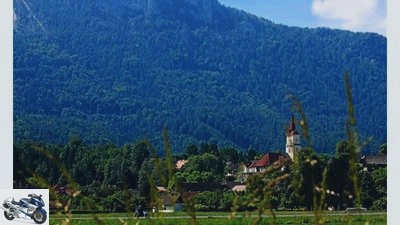
shepherd
Now quickly continue towards Essen and the Ruhr area.
On a stage below the cathedral, a Roma combo is heating up with flamenco rhythms. A few corners further a marching band trumpets. Festival atmosphere in a city that until recently I neither knew how it was pronounced nor in which country it was located. “Paitsch”, says Támas.
The music evaporates high above the city. Idyllic hill country, lakes and ponds glow in the afternoon light. Only towards the south-east do large areas escape the romantic low mountain range. Dark areas, dilapidated industrial complexes. It is the legacy of mining, which, like in the Ruhr area, first gave people work and then took it away again.
Támas says goodbye to Hungary west of Lake Balaton. And there it is more curvy than expected. The tires are getting rounder again, and at the Austrian border I can’t resist the temptation to take a detour over the Grobglockner. Capitals of culture are all well and good, but a motorcycle cult site in between is not wrong either. At the top of the pass, it is refreshing between the old snow fields. Heated grips think of the street of fire that awaits me in Essen.
The fire is long gone, but the street of fire is more alive than ever. After a lively two-day ride from the Grossglockner, I am now in the midst of French, Japanese, Dutch and many others at Zollverein. Or rather, at the Zollverein coking plant. A line of 304 ovens that baked coal into coke at an infernal 1400 degree heat gave the street of fire its name. Zollverein supplied the iron and steel works with the elementary fuel for iron and steel production. A monster when it was in operation. You can now feel the pulse of the new here. Art instead of coal. Coal for art.
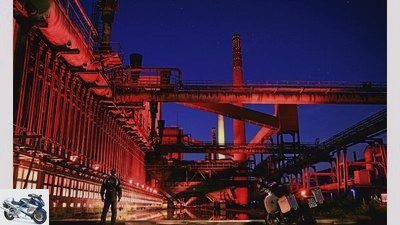
shepherd
Now to the last of the three stations: The street of fire is still glowing in Essen.
However, Zollverein is not a museum temple that leaves Otto Normal behind. On the contrary: when the streams of visitors dissolve and I tie my camera and tripod back to the Xchallenge in the parking lot, one of the stewards comes up to me: “Don’t you want to drive your bike on the site and put it in the picture? It sure looks nice.” The man can read minds.
I spend another day on vacation in the area that has become home to me. Drive to the other imposing backdrops, behind whose facades something new is happening. The dull brown cylinder of the gasometer, in which the largest artificial moon hangs, and the Villa Hugel above Lake Baldeney, where the Krupp entrepreneurial family resided. The rails of the Baghdad Railway come back to me. The world was global even before we started talking about globalization.
While I’m at the Baldeneysee, I have a coffee at Scheppen, the motorcycle meeting point in the Ruhr area. As always, at least a handful of motorbikes are parked by the lake, and I join the queue for those in need of coffee. When a bike is not being started, you can hear the clink of spoons that stir milk and sugar in the coffee cups from the babble of voices. Coffee is always drunk here somewhere.
meal
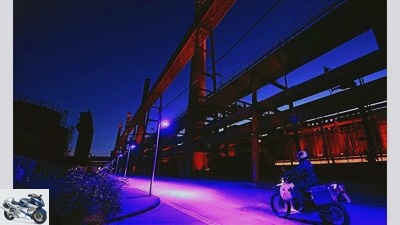
shepherd
Essen: Germany – European Capital of Culture as part of “Ruhr 2010” – Area: 210.31 km2 – Founding: 852 AD – Population: 576,259
Essen was the first time a city was chosen to represent a region as the Capital of Culture. This not only honored the change in the Ruhr area, but also broke prejudices about a region. This is where what fits and what doesn’t, but is always interesting, meet. The typical lifestyle of the residents and the energy of this region are reflected in the overall experience “main cultural capital” noticeable. Pretty and ugly, fine art, Love Parade, corner pub and star kitchen, allotment garden and landscape park, concert hall and football stadium are always very close to one another, forming a dynamic dialogue of opposites. The stories of the arts, the many cultures, the creative industries, the destroyed nature and its reclamation are the main elements of the many events. The action with the most visitors was the so-called still life. Several million people turned 60 kilometers of the A 40 between Dortmund and Duisburg into an art, picnic and stroll route for one Sunday. There are also numerous program items in Essen and in the Ruhr area beyond the 2010 Capital of Culture year. More information at www.Ruhr2010.de
Pecs
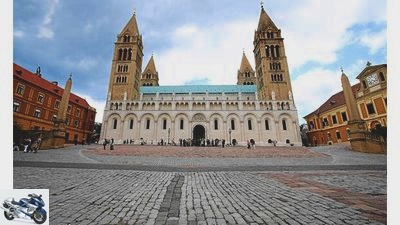
shepherd
Pecs: Hungary – European Capital of Culture: 2010 – Area: 162.61 km2 – Founding: 3rd century AD – Population: 157,680
The Hungarian industrial center of Pecs and Essen have a lot in common. The decline in coal mining is one of them. At the same time, one looks back on a cultural diversity and, especially in the case of Pecs, a rich and varied history. The city was shaped by the Romans and Turks, as was the socialist influence centuries later. Despite, or perhaps because of, its modest size, it presents itself as a livable, well-arranged and varied city. For the successful coexistence of the colorfully mixed nations in the city, Pecs has been awarded the UNESCO Peace Prize. Pecs is located near the Croatian border and is the seat of a bishopric, university town and county seat of Baranya County. The climatically favorable location at the foot of the Mecsek Mountains and numerous architectural monuments give the place a Mediterranean atmosphere. Pecs is also the center of the Danube Swabians and home to nine ethnic minorities with their own self-governments.
Istanbul
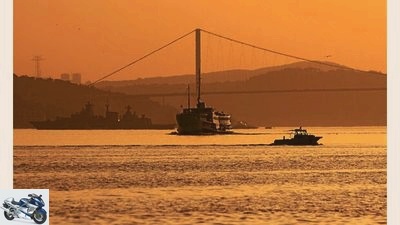
shepherd
Istanbul: Turkey – European Capital of Culture: 2010 – Area: 1830.92 km2 – Foundation: 660 BC – Population: 12782960
Why does a city become a cultural capital that does not belong to the EU? With the constant expansion of the EU, in addition to one applicant each from the old and new member states, a city from the EU accession candidates is also chosen. Istanbul looks back on 8,000 years of history at the interface between Europe and Asia. For this reason, but also because Istanbul wants to promote cultural exchange with Europe, the EU jury gave the city on the Bosporus the award. Searching for one’s own identity, as the Ruhr area is doing in 2010, is not an option for Istanbul. The city has too many identities that are nested vertically and horizontally. Istanbul, first called Byzantium, then Constantinople, is the only big city in the world that is on two continents. The friction between them is enormously beneficial for the cultural and business location, and so the megacity is more progressive than the rest of Turkey.
Travel info

shepherd
Travel time: 14 days – Distance covered: 3000 kilometers
Because a motorcycle had to be transferred anyway, our author drove from Istanbul via Pecs to Essen, thus connecting the 2010 capitals of culture, which were almost in line
Arrival / travel time:
Istanbul as the starting point of the trip can be reached via a number of routes. In addition to the classic “Autoput” through the states of the former Yugoslavia and Bulgaria, there are ferry connections from Ancona / Italy to Cesme / Turkey with www.marmaralines.com. Alternatively, the www.dbautozug.de runs in combination with the Optima-Express (www.optimatours.de) to Edirne / Turkey. Except in winter, the route is easy to travel. In the Balkans and for crossing the Alps, an extra sweater is recommended during the rest of the year.
The distance:
Whether with the cruiser, athlete or 125: the route offers good to the best conditions for all bikes. If you take a detour from the main route, the road condition changes a league downwards. Off-road inserts are particularly feasible in Turkey and the Balkan countries. An identity card is sufficient for entry into all countries. The green insurance card for motorcycles should be valid for all countries. If not, short-term insurance must be taken out at the border. There is a toll requirement on the motorways of the countries visited.
Stay:
The overnight stays in Istanbul and Pecs were organized via the portal www.couchsurfing.org, where travel enthusiasts made guest beds available to other travelers. In Sofia / Bulgaria the Renaissance Hotel (www.renaissance.yes.bg) and in Maribor / Slovenia the Hotel Orel (www.termemb.si) offered a comfortable roof over one’s head.
Activities:
In the cultural capitals of Istanbul, Pecs and Essen there is more program than can be covered during a holiday. Tip Istanbul: take the ferry from the Sirkeci district below the Topkapi Palace over the Bosphorus to Haydarpasha and enjoy the incredible views. Tip Pecs: The underground burial chambers and chapels are UNESCO World Heritage Sites and are always worth a visit. Tip Essen: The Zollverein coking plant is one of the most impressive structures that modern industrial history has produced. Here you should definitely join one of the guided tours offered.
Cards:
The Balkan map by Freytag and Berndt for 9.95 euros covers the entire travel area up to Bavaria on a scale of 1: 2,000,000. All the main routes are listed in it. Many connections in the countries of the former Yugoslavia are currently being rehabilitated or newly built. It is therefore possible that the map information is not always up-to-date.
Related articles
-
to travel Ruhr area Ruhr area Layer in the pot The area is in a state of upheaval. Steel mills are being transformed into adventure parks, mines into…
-
to travel Istanbul Istanbul Adventure Bosphorus Anyone who gets involved in Istanbul stands right at the crackling seam of two continents. Asia and…
-
On the way: Hautes Alpes-Piemont – Italian-French border area
Schlueter to travel On the way: Hautes Alpes / Piedmont – Italian-French border area On the way: Hautes Alpes / Piemont (with GPS route) Off-road…
-
Daams to travel Bonn and the surrounding area Bonn and the surrounding area Bonn plus ultra Federal capital ?? that is a thing of the past for Bonn. But…
-
Rukka Shield-R: With air cushion in the seat area
Rukka 5 pictures Rukka 1/5 The latest Rukka textile combination consists of the Shield-R jacket and the Shield-R pants. Rukka 2/5 The Rukka Shield-R…
-
BMW CE 04: With electric power through the metropolitan area
News 2022 New motorcycle items for 2022 BMW 27 pictures BMW 1/27 With the CE 04, BMW brings the successor to the C Evolution. BMW 2/27 The new electric…
-
Michael Schroder: my home route
Artist to travel Michael Schroder: my home route Michael Schroder: my home route Swabian home run Nothing beats your personal home route. Why? Nowhere do…
-
Motorcycle tour Panamericana part 1
Army car 27 pictures Army car 1/27 A MOTORRAD volunteer fulfills a lifelong dream: from Alaska to California on a motorcycle. Army car 2/27 Pure nature:…
-
Daams to travel Out and about in Germany Out and about in Germany From Frankfurt to Frankfurt Two cities with the same name. Which largely exhausts the…
-
Motorcycle trip in the Pyrenees
shepherd 33 pictures shepherd 1/33 Motorcycle trip in the Pyrenees – From the Mediterranean to the Atlantic. shepherd 2/33 Air sovereignty: Giant…